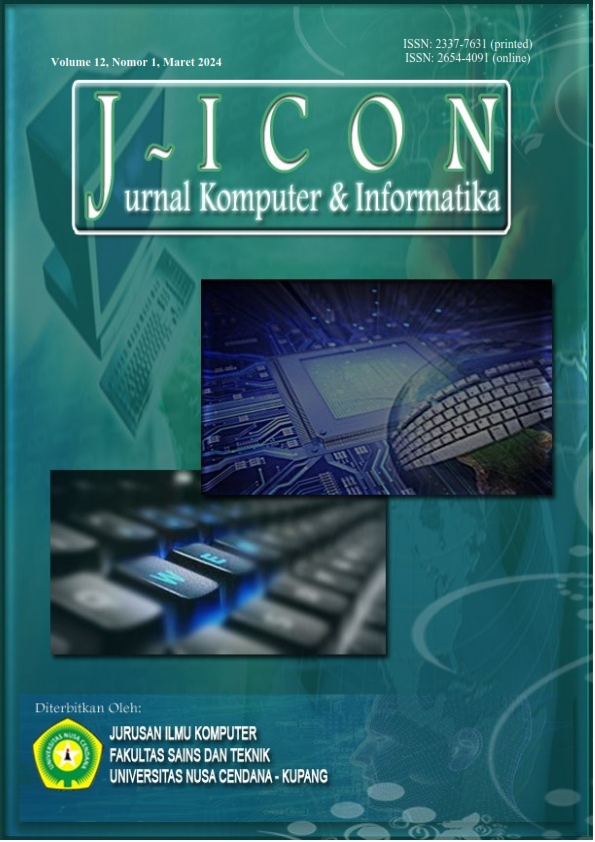APPLICATION OF THE LSTM (LONG SHORT TERM MEMORY) METHOD IN SENTIMENT ANALYSIS TOWARDS THE IMPLEMENTATION OF THE ELECTION DURING THE COVID-19 PANDEMIC
Abstract
The implementation of regional elections in the midst of the Coronavirus disease 2019 (COVID-19) pandemic has become the spotlight and discussion of the wider community. This is because it involves many people so that it becomes one of the risks of transmission of the virus. Therefore, this study analyzes how public sentiment towards the elections amid the COVID-19 Pandemic. One method used in sentiment analysis is Long Short-Term Memory (LSTM). LSTM is a development of the Recurrent Neural Network (RNN) model that can replace problematic RNN nodes in the hidden layer with LSTM cells designed to store previous information. The data used in this research is Indonesian tweet data taken from Twitter with a total of 5053 data classified into positive and negative sentiment classes. The data from the tweets is preprocessed first to make it easy to classify, then selected and transformed to be processed in data mining using LSTM. The LSTM classification was evaluated using the Confusion matrix to obtain an accuracy of 79,78%, a precision of 69% and a recall of 64%. Tests were also carried out with different epochs and dropouts, it was found that the average accuracy value was more than 80%, and the greatest accuracy was obtained with epoch of 45 and dropout of 20.
Downloads
References
D. Handayani, D. R. Hadi, F. Isbaniah, E. Burhan, and H. Agustin, “Penyakit Virus Corona 2019,” Jurnal Respirologi Indonesia , vol. 40, no. 2, pp. 119–129, 2020. [Online]. Available: https://www.jurnalrespirologi.org/index.php/jri/article/view/101.
S. F. Aliyah, H. Yasin, S. Suparti, B. Warsito, and T. Widiharis, “Analisis Sentimen PT Tiki Jalur Nugraha Ekakurir (PT Tiki JNE) Pada Media Sosial Twitter Menggunakan Model Feed Forward Neural Network,”, J. Statistika Unimus, vol. 11, no. 2, 2020. [Online]. Available: https://jurnal.unimus.ac.id/index.php/statistik/article/view/6087.
F. A. Nugraha, N. H. Harani, R. Habibi, and Rd. N. S. Fatonah, “Sentiment Analysis on Social Distancing and Physical Distancing on Twitter Social Media using Recurrent Neural Network (RNN) Algorithm,” Join, vol. 5, no. 2, pp. 195–204, 2020, doi: 10.15575/ join.v5i2.632.
L. Wiranda and M. Sadikin, “Penerapan Long Short Term Memory pada Data Time Series untuk Memprediksi Penjualan Produk PT. Metiska farma”, janapati, vol. 8, no. 3, pp. 184–196, 2020, doi: 10.23887/janapati.v8i3.19139.
A. R. T. Lestari, R. S. Perdana, and M. A. Fauzi, “Analisis Sentimen Tentang Opini Pilkada DKI 2017 Pada Dokumen Twitter Berbahasa Indonesia Menggunakan Naive Bayes dan Pembobotan Emoji”, J-PTIIK, vol. 1, no. 12, pp. 1718–1724, 2017. [Online]. Available: https://j-ptiik.ub.ac.id/index.php/j-ptiik/article/view/627.
S. Juanita, “Analisis Sentimen Persepsi Masyarakat Terhadap Pemilu 2019 Pada Media Sosial Twitter Menggunakan Naive Bayes,” J. MEDIA Inform. Budidarma, vol. 4, no. 3, p. 552, 2020, doi: 10.30865/mib.v4i3.2140.
R. Cahyadi, A. Damayanti, and D. Aryadani, “Recurrent Neural Network (RNN) dengan Long Short Term Memory (LSTM) untuk Analisis Sentimen Data Instagram,” JIKO, vol. 5 no. 2, 2020, doi: 10.26798/jiko.v5i1.407
D. A. Lionovan, L. W. Santoso, and R. Intan, “Klasifikasi Topik dan Analisa Sentimen Terhadap Kuesioner Umpan Balik Universitas menggunakan Metode Long Short-Term Memory,” Jurnal Infra, vol. 8, no. 2, 2020. [Online]. Available: https://publication. petra.ac.id/index.php/teknik-informatika/article/view/10512
A. A. Mudding and Arifin A Abd Karim, “Analisis Sentimen menggunakan Algoritma LSTM Pada Media Sosial”, JUPIKOM, vol. 1, no. 3, 2022. doi: 10.55606/jupikom.v1i3.517.
A. Muzaki and A. Witanti, “Sentiment Analysis of the Community in The Twitter to The 2020 Election In Pandemic COVID-19 By Method Naive Bayes Classifier ”, JUTIF, vol. 2, no. 2, pp. 101-107, 2021. doi: 10.20884/1.jutif.2021.2.2.51.
M. A. Nurrohmat and A. SN, “Sentiment Analysis of Novel Review Using Long Short-Term Memory Method,” IJCCS, vol. 13, no. 3, p. 209, Jul. 2019, doi: 10.22146/ijccs.41236.
M. Bramer, Principles of Data Mining, vol 3, University of Portsmouth, Portsmouth, Hampshire, UK: Springer, 2016.
J. Han, M. Kamber, and J. Pei, Data Mining: Concepts and Techniques Third Edition, 2011.
Copyright (c) 2024 Dika Melati, Herfina Herfina, Mulyati Mulyati

This work is licensed under a Creative Commons Attribution 4.0 International License.
The author submitting the manuscript must understand and agree that if accepted for publication, authors retain copyright and grant the journal right of first publication with the work simultaneously licensed under a Creative Commons Attribution (CC-BY) 4.0 License that allows others to share the work with an acknowledgment of the work’s authorship and initial publication in this journal.
 Dika Melati(1)
Dika Melati(1)




